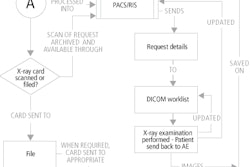Healthcare providers are increasingly demanding mobile computing devices for use as decision-support tools. And wireless networking is a fundamental enabling technology for mobile computing. For example, it gives users the ability to show images to patients in a more intimate fashion than a standard PC, according to Dr. Paul Chang, director of radiology informatics at the University of Pittsburgh Medical Center.
"Those of us in radiology may not be pushing hard for mobile computing, but certainly people within your department outside of radiologists are -- your technologists and your nurses," he said. "And certainly outside of radiology the demand for mobile devices is ever-increasing, which gives a big push for wireless."
Chang discussed wireless networking during a talk in March at PACS 2004: Working in an Integrated Digital Healthcare Enterprise, in San Antonio. The meeting was sponsored by the University of Rochester School of Medicine and Dentistry in New York.
In addition to serving as the foundation for mobile computing, wireless can be a more cost-effective option for providing network access in situations when installation of cable or fiber would be too expensive or unwieldy, Chang said. It can also confer broadband access to locations where other options such as DSL or cable modem are not available -- in rural areas, for example. And wireless technology can provide a "personal-area network" to users, allowing for PDAs, pagers, mobile phones, printers, headphones, and other devices to interoperate without wires, Chang said.
The three major wireless LAN options today are 802.11b, 802.11a, and 802.11g, Chang said.
801.11b
Wi-Fi, or 802.11b, uses an operating frequency of 2.45 GHz, with 2-5 megabits per second real-world bandwidth and a range of about 300 feet. Currently the most popular wireless LAN offering, it’s relatively inexpensive and benefits from good vendor interoperability and support by many portable devices, Chang said.
However, multiple clients communicating with a single access point must share bandwidth, and current implementations have serious security vulnerabilities; most users still employ the now-discredited single wired equivalent privacy (WEP) key.
"(The single WEP key) is a total joke," he said.
The protocol also suffers from potential collisions or interference from other access points, as well as Bluetooth devices, portable phones, and microwave ovens, Chang said.
802.11a
Another WLAN option, 801.11a, operates on the 5 GHz operating frequency, with an expected real-world bandwidth of 20 to 32 megabits/second and a range of about 200 feet. It provides significantly greater bandwidth for clients to share, and includes better security capabilities such as temporal key integrity protocol (TKIP), advanced encryption standard (AES), and 801.1X (extensible authentication protocol (EAP) using Ethernet frames, Chang said.
However, "the newer technologies for wireless security are still vulnerable to something called dictionary attacks," he said. "Don’t fool yourself into thinking all of these newer acronyms are safe; they just take a little bit longer (to break through)."
The 802.11a option receives less interference from Bluetooth, phones, and microwave ovens, and may be the best technology to use in relatively small areas with numerous users, such as conference rooms, Chang said.
As with all wireless technology, 802.11a is a shared resource, and security is still not "enterprise-strength," he said. In addition, 802.11a is not backward compatible with 802.11b, is more expensive, and may require additional access points due to its reduced range.
802.11g
Operating at a 2.45 GHz operating frequency, 802.11g offers a bandwidth of 12 to 24 megabits/second. It has a range of at least 300 feet and possibly longer, Chang said.
It offers significantly greater bandwidth to share among clients, as well as the security benefits of 802.11a, he said.
It’s also backward compatible with 802.11b, and may have a greater distance range compared to 802.11a and 802.11b, Chang said. It may be the best technology to use in large areas with relatively few users, such as warehouses.
802.11g is also a shared resource, and as with 802.11b and 802.11a, security is still an issue. In addition, bandwidth performance will probably not be as good as 802.11a, and it’s more expensive than 802.11b.
Since it utilizes the same operating frequency as 802.11b, it’s subject to the same potential collisions/interference. And 802.11g suffers from diminished performance when supporting both 802.11b and 802.11g clients, Chang said.
Practical advice
Chang offered practical suggestions for prospective wireless network users. First, at least make an attempt with security, turning on at least WEP security with 128-bit encryption.
"Anything is better than nothing," he said.
Also, insist on more robust security offerings, such as Wi-Fi protected access (WPA), TKIP, and AES, Chang said. A new security update for the 802.11 standard, 802.11i, combines a number of these security mechanisms, and should be required of any wireless vendor.
Consider using only static IP addresses for wireless clients, and don’t use dynamic host configuration protocol (DHCP), Chang said. In addition, users should not employ the default Extended Service Set Identifier (ESSID), and should not broadcast the ESSID.
"You might also consider using MAC address access only," Chang said.
Placing wireless access points in the middle of the coverage area may reduce signal "leakage" at the edges of the area, minimizing interference and improving security, he said. Important servers or clients should not be placed on a wireless LAN.
Chang also recommends that users consider employing a virtual private network (VPN) when using wireless clients, as well as a "nested" firewall strategy for all systems that can be accessed using wireless clients. A "just-in-time" data delivery or image streaming mechanism may also be warranted, to ease loads on the shared wireless bandwidth, he said.
By Erik L. RidleyAuntMinnie.com staff writer
April 2, 2004
Related Reading
Tablet PC eases image distribution to bedside, March 23, 2004
Security strategies for wireless technology, June 10, 2003
Filmless ED can open the door for enterprise-wide PACS, May 9, 2003
Wireless Internet lines offer speedy alternative for imaging centers, September 3, 2002
Wireless not yet secure enough for prime time, May 6, 2002
Copyright © 2004 AuntMinnie.com


















